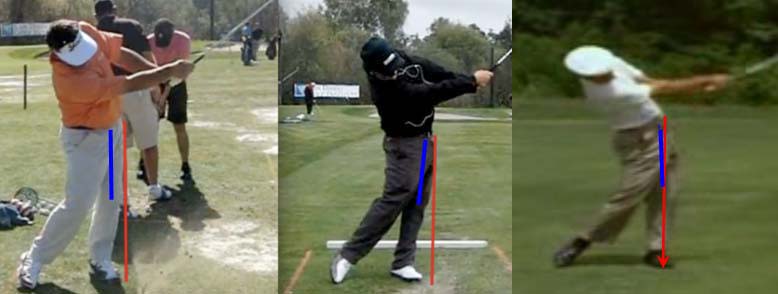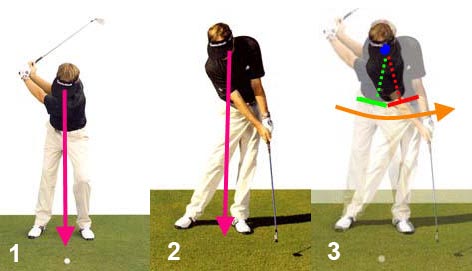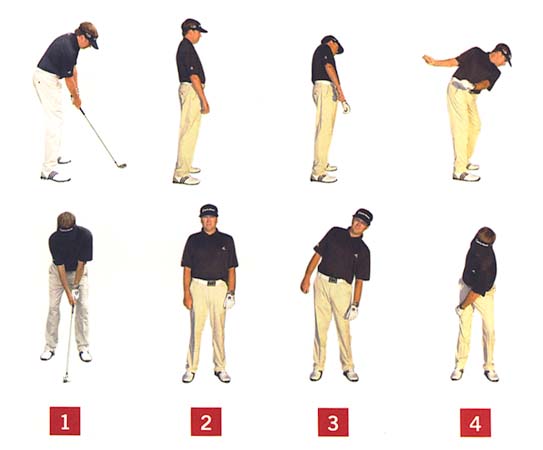|
|
Post by gmbtempe on Mar 13, 2010 22:16:23 GMT -5
Interesting on the CP versus CF....though I definitely feel a different motion with both types of moves, I doubt I could release with a full roll horizontal hinge in my CP motion unless I had the face open, a lot.
|
|
|
|
Post by iteachgolf on Mar 13, 2010 23:09:31 GMT -5
Angled hinging with both CP and CF swings for me unless I have to do something strange.
|
|
|
|
Post by imperfectgolfer on Mar 14, 2010 0:23:53 GMT -5
Dan, I stand by my position that your swing is more like Bennett/Plummer's S&T model than Brian's swing. However, you may be increasingly trying to move him in a S&T direction. Consider your red lines drawn in the followthrough.  I still think that your pelvis is shifted more leftwards. I have added an image of Ben Hogan. The red arrowed line is drawn from the outer border of his left pelvis vertically down to the ground - it hits the ground inside the outer border of his left foot. I have also drawn a blue line down the middle of the left thigh. Brian's left thigh is near-vertical, your left thigh is angled to the right while Ben Hogan's left thigh is angled to the left - as judged from top-to- bottom of the left thigh. In terms of left-lateral pelvic slide to the left - you have more than Brian, and Brian has more than Ben Hogan. I much prefer a pelvic motion that keeps the outer border of the left pelvis inside the outer border of the left foot - at impact/ followthrough. I know of no biomechanical/mechanical/geometrical advantage to i) incorporating a leftwards tilt into the spinal bend inclination angle and ii) using an assertive left-lateral pelvic slide action to reverse that tilt. I much prefer the mechanics/biomechanics of Ben Hogan's swing. Jeff. |
|
|
|
Post by gmbtempe on Mar 14, 2010 0:38:58 GMT -5
Wonder what would be easier to do, the full Hogan pattern or the SnT pattern?
I am probably in the minority but Hogan's swing while awesome has some difficult pieces to copy.
|
|
|
|
Post by imperfectgolfer on Mar 14, 2010 1:27:41 GMT -5
Greg, I don't know which parts of Hogan's swing you think is difficult to copy.  However, there are two key elements that I think all golfers should copy. 1) He has a rightwards-tilted backswing swing action with a reverse-K posture at the end-backswing position (image1) and he doesn't look at all like a S&T golfer (who is vertically stacked). 2) He keeps the outer border of his left pelvis inside the outer border of his left foot throughout the entire downswing and followthrough. Jeff. |
|
|
|
Post by iteachgolf on Mar 14, 2010 2:16:13 GMT -5
Dan, I stand by my position that your swing is more like Bennett/Plummer's S&T model than Brian's swing. However, you may be increasingly trying to move him in a S&T direction. Consider your red lines drawn in the followthrough.  I still think that your pelvis is shifted more leftwards. I have added an image of Ben Hogan. The red arrowed line is drawn from the outer border of his left pelvis vertically down to the ground - it hits the ground inside the outer border of his left foot. I have also drawn a blue line down the middle of the left thigh. Brian's left thigh is near-vertical, your left thigh is angled to the right while Ben Hogan's left thigh is angled to the left - as judged from top-to- bottom of the left thigh. In terms of left-lateral pelvic slide to the left - you have more than Brian, and Brian has more than Ben Hogan. I much prefer a pelvic motion that keeps the outer border of the left pelvis inside the outer border of the left foot - at impact/ followthrough. I know of no biomechanical/mechanical/geometrical advantage to i) incorporating a leftwards tilt into the spinal bend inclination angle and ii) using an assertive left-lateral pelvic slide action to reverse that tilt. I much prefer the mechanics/biomechanics of Ben Hogan's swing. Jeff. Hogan is hitting a driver versus me hitting a 9 iron and Brian a 6 iron. You should also note that U have the narrowest stance out of Brian, me , and Hogan. Hogan has his pelvis the most forward from where it was at setup but his wide stance keeps his left hip inside his left foot. The fact that you would choose a driver swing with an extremely wide stance and try to use his left hip to left foot as a way to judge amount of forward pelvic motion is very flawed. How about checking how far his belt buckle is from his right foot? Again at least driver to driver is a more fair comparison, even though my stance is more narrow and Hogan's left knee is clearly outside his left foot and it is plain as day that Hogan has a MUCH greater lateral motion (middle of both our left legs are inline with the ball at the top and at the followthrough the back of my left leg is even with the ball when Hogan's entire pelvis is in front of the ball). "In terms of left-lateral pelvic slide to the left - you have more than Brian, and Brian has more than Ben Hogan. " So this quote is pretty much completely false. When you have a hammer it is easy to see everything as a nail. 3JACK EDIT: Dan, had to modify some of the post to keep away from the condescending tones. I certainly understand your issues with Jeff's theories, but if you find his thoughts incorrect, just state that they are incorrect and why. Attachments:
|
|
|
|
Post by gmbtempe on Mar 14, 2010 10:33:44 GMT -5
Whats interesting about the three photo's the persons back who I would be most concerned about would be Hogans, man that is one big reverse C. When I think about those huge rervese C finishes like Hogan and Nicklaus, did those guys have back issues? I have heard people say that Hogan actually got more to the right at the top where he transitions than anyone, so comparing Dan is going to show the biggest difference. I look at Dan's top and I just don't think its bad at all, I would say neutral and not to the left, obviously the weight is on the left leg though. I like the attached top position best. Attachments:
|
|
|
|
Post by imperfectgolfer on Mar 14, 2010 11:33:40 GMT -5
Dan,
I was not comparing the extent of the left-lateral pelvic motion when I was comparing Hogan's swing to your S&T swing. I was only discussing the element of the outer border of the left pelvis relative to the outer border of the left foot.
A golfer who has a rightwards-centered backswing action swing style obviously has to have more overall left-lateral pelvic slide action - because they first have to move leftwards to re-weight their left leg before they complete a "left hip clearing action". By contrast, a S&T golfer is already significantly weighted over the left leg at the end-backswing position.
I still think that there is a significant difference between Brian's present swing style (which I classify as rightwards-centralised) and a full-fledged S&T swing (which I classify as leftwards-centralised). I know of no biomechanical/mechanical/geometrical advantage to converting Brian from his present rightwards-centralised backswing action swing style to a leftwards-centralised backswing action swing style. Can you think of why Brian would benefit if he became much more like a full-fledged S&T golfer (ala the Bennett/Plummer model)?
Jeff.
|
|
|
|
Post by imperfectgolfer on Mar 14, 2010 11:57:02 GMT -5
Greg, You wrote-: "I look at Dan's top and I just don't think its bad at all, I would say neutral and not to the left, obviously the weight is on the left leg though." I don't think that you understand my viewpoint - which has been expressed exhaustively in this thread. A S&T golfer has a vertical/stacked appearance at the end-backswing. However, included in that vertical posture is 30 degrees of leftwards spinal tilt, which is visually masked because they change their angle of spinal bend inclination when they incorporate that leftwards-tilt in their swing, so that they remain stacked (upper swing center remains stationary). The situation becomes apparent in the downswing - they have to use a left-lateral pelvic slide action to correct the spine tilt and most of the lateral motion occurs at the level of the lumbar spine.  By contrast, Ben Hogan may have more overall left-lateral pelvic motion, but the left-lateral motion is not occurring primarily at the level of the lumbar spine.  Note how much Hogan's pelvis moves left-laterally in his downswing - it is much more than that seen in a S&T golfer's swing. However, note that the upper swing center and lower swing center both move leftwards in the downswing (but not at the same linear speed), and he constantly has rightwards spinal tilt throughout the downswing. That's the major difference! A S&T golfer, by contrast, has to keep his upper swing center stationary, and that forces all the latriflexion forces to be primarily targeted at the level of the lumbar spine. Jeff. |
|
|
|
Post by gmbtempe on Mar 14, 2010 12:03:06 GMT -5
I would like to hear from someone like Dan, who I am going to guess was a very good golfer before SnT, what difference did they see in their ball striking after switching? What convinced them this was the way to go? What did it do for your game that was lacking?
|
|
|
|
Post by gmbtempe on Mar 14, 2010 12:09:16 GMT -5
Jeff,
So Hogan, what does he have 20 degrees of rightwards spinal tilt? SnT 30 degrees leftwards?
So there is like +/- 50 degrees between the two swings?
This is what I don't understand, I thought all golfers had tilt to the left just that SnT took it a little further.
Your point about the pelvis and swing centers makes sense to me, the further left you are the more you are going to have to push the pelvis while keeping the swing center stationary.
|
|
|
|
Post by imperfectgolfer on Mar 14, 2010 12:13:15 GMT -5
Greg,
You wrote-: "Whats interesting about the three photo's the person's back who I would be most concerned about would be Hogans, man that is one big reverse C."
I think that you are making a major mistake when you assess the effect of a reverse C posture on a golfer's lower back. It is not the degree of secondary axis tilt that quantifies the reverse-C problem re: the lower spine. It is the angle of the lower spine relative to the angle of the thighs. If two golfers have the same degree of secondary axis tilt, but golfer A's left thigh slants leftwards (from top to bottom) while golfer B's left thigh slants rightwards (from top to bottom), then golfer B's lumbar spine is being subjected to a much greater level of latriflexion force.
Jeff.
|
|
|
|
Post by imperfectgolfer on Mar 14, 2010 12:24:34 GMT -5
Greg, You wrote-: "So Hogan, what does he have 20 degrees of rightwards spinal tilt? SnT 30 degrees leftwards? So there is like +/- 50 degrees between the two swings?" No! First of all, I am only discussing the backswing action. Hogan probably has ~ 6 degrees of rightwards spinal tilt at address and roughly the same amount at the end-backswing position if measured between the lowest lumbar vertebra (L5) and the highest thoracic vertebra (T1). By contrast, a S&T golfer has roughly 0 degrees - if measured in the same way (from the top-to-the bottom) - because he is vertically stacked. However, to become vertically stacked, and prevent that natural ~6-8 degrees of rightwards spinal tilt that exists in a traditional swing, a S&T golfer has to incorporate 30 degrees of leftwards spinal tilt in his backswing action. That 30 degrees is not visually-apparent, because it gets incorporated into their change in spinal bend inclination angle.  In image 3, Andy is tilting 30 degrees leftwards. However, in image 4 he appears to be vertically-stacked with no leftwards tilt. Jeff. |
|
|
|
Post by gmbtempe on Mar 14, 2010 13:22:26 GMT -5
If a SnT golfer uses 30 degrees bend leftwards to achieve 0 degrees vertical at the top then how many degrees left does Hogan bend to get 6-8 degrees right, 22 or so?
I mean Hogan does have leftwards tilt as he makes his backswing?
|
|
|
|
Post by imperfectgolfer on Mar 14, 2010 19:18:59 GMT -5
Greg, I don't think that Hogan has to include any leftwards tilt to maintain a 6 degrees rightwards tilt in the backswing. However, if he has a >90 degrees shoulder turn in the backswing (which he often does for driver swings), the large shoulder turn torques the upper thoracic spine leftwards. In that specific sense, a rightwards-centralised backswing action swing style can produce leftwards tilt of the upper half of the spinal coumn. However, if a rightwards-centralised backswing swing style golfer avoids torquing the upper thoracic spine leftwards (by having a large shoulder turn), then the degree of rightwards tilt should not change during the backswing action. Slicefixer's students, who use the 9-to-3 swing style, have a shorter backswing action, and they do not torque their upper spine leftwards. www.youtube.com/watch?v=12KHR1xr2SANote that they use a rightwards-centralised backswing action swing style, and they do not torque their spine leftwards during the backswing. Jeff. |
|